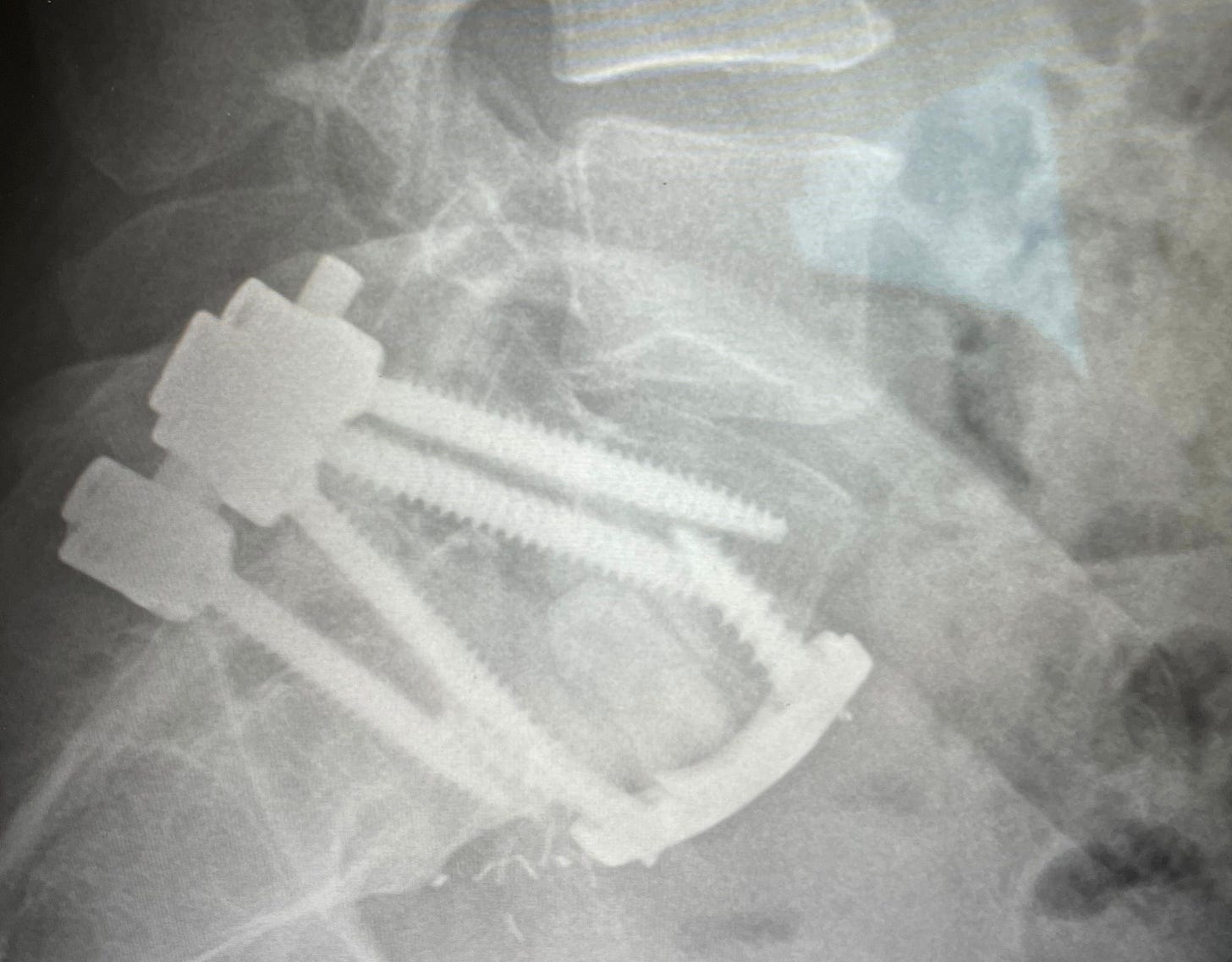The art of running 100 miles on a busted spine
After a serious slipped disc, Chris McBride battled back to complete the IMTUF 100-mile race just 6 months after surgery, and a lifetime of setbacks
It would be normal to think that your life as a runner might be over when you have serious invasive surgery on your spine. Christopher McBride, however, was determined to run a 100-mile race just six months after his surgery.
Over a decade into his trail running career, Chris regularly stepped up onto podiums at the end of races, but his back was hurting. It hurt enough to go see a doctor, and the prognosis wasn’t great. It was a slipped disc, but there were some more surprises along the way.
Regardless, he had the Idaho Mountain Trail Ultra Festival to contend with, and he wasn’t about to give up his race fee.
From XC to the trails
It’s clear from the beginning of our conversation that Chris has always thought about what’s bigger. What’s next?
How did Christopher McBride become someone who runs 50,000 miles over a lifetime? Let’s call that 25 years of running 2000 miles a year, for context’s sake.
“It goes back to being a teenage father from a little rural town in Washington where the feed store is bigger than the grocery store. I just can't escape that chip on my shoulder.”
Having had some success in 800m track, he asked what could be next, and decided on cross country. But his school didn’t have a cross country team. So he asked the neighboring school if he could train with their cross country team. The coach accepted.
After just a month, Chris – wearing his own school’s first cross country singlet – started beating the new boys he was training with in grueling 5000m redline races. It was time to spread his wings.
Chris duly entered and won the Small School League Championship, and then finished 12th in State, but because he was 1) a “horrible student,” and 2) had a child in his senior year, he wasn’t ready to join a Division 1 college.
A couple of years of community college, followed by a scholarship to one of the best programs in the country (“a powerhouse team 50% composed of international athletes” — a rarity back then), and things were looking up, but it wasn’t to last.
His stuttered education caused his first serious unexpected setback as a runner. Chris became ineligible for college competition before he could graduate. His scholarship was about to end. What was next? An extended break from running.
“It was a scary, depressing time in life. Running had paid the bills up to that point and wasn't an option any more. I stopped running completely and threw myself into school, and after I graduated, I had a young family.”
Chris didn’t run again until remarrying and starting a new family in his 30s. As life allowed him a moment to get back into running, he joined some local running clubs and graduated to the trails from there.
The injury
“Before I got it diagnosed, I would have episodes of really bad back pain during a run. I would say to the guy next to me, ‘My back's killing me.’ They always replied, ‘My back hurts too.’ I just assumed that was just living.”
It’s an interesting question, isn’t it? How do you gauge pain? Doctors have a 1-10 scale for patients to refer to, but what if you’ve never experienced a 10 before? Everyone’s ‘pain tolerance’ is different. How seriously should one take the sharp pain? Christopher’s breaking point was when his day-to-day life was being massively affected.
In the lead-up to the 100-mile race in 2023, “it was just really, really painful most of the times that I ran.”
“I didn't know what the pain was. I just knew my spine hurt.”
“Towards the end, I couldn't do anything to relieve it or not experience pain when running. I couldn't stand, and I couldn't lay on my back. Going to sleep was really difficult because I had to do so many crazy things to find a comfortable spot. That's when I went to the doctor.”
When Chris went in for x-rays on his back, he discovered that he had a slipped disc. So far, so what, right? It had slipped to the extent that the x-ray tech was visibly excited. It was a grade 3 slipped disc, which means that it had moved over 50% out of position.
He estimates that he’d been nursing his injury by adjusting his posture and trying to live with the discomfort for two years prior to the diagnosis.
During the x-rays and MRIs, Chris received two extra bombshells. First, he discovered that he had been born with spina bifida, a congenital disease where the backbone doesn’t fully form and is thus weakened, but there was more!
“Because of the weakness, it turns out that I had broken the parts of my back that hold things into place as an adolescent, and that's what allowed [the disc] to slide over time.
“I'm so incredibly thankful this was missed [at birth]. God knows what Forrest Gump contraptions they would have put me in during the early ‘70's.”
The comeback
Due to the beauty of one’s access to the American healthcare system being tied to one’s place of work, it was six months between the September 2023 diagnosis and the back surgery taking place in March 2024.
Christopher McBride had a goal of running the IMTUF 100-mile race on 21st September 2024. That left just 199 days to recover from the surgery and train for a race distance that feels alien to 99.9% of the world.
And guess what. His doctor didn’t get it.
“My first couple of post-surgery check ups with the surgeon were really upsetting. Even when they're faced with a life-threatening heart disease, most Americans won’t get out and walk.”
“His experience is working with those people. Getting them to walk each day is an accomplishment. He had no advice for somebody who’s been a competitive runner since childhood.”
Chris was determined to build back up slowly, but surely. He was walking the day after surgery. Just half a mile, but he was walking. Each week for 10 weeks he added another half mile to his daily walks until he was at a five-mile walk. Only then did he add running.
The next 15 weeks were spent gradually increasing the mileage, training to run 103 miles while climbing 21,000 feet of one of the tougher, more technical American trail races.
This was not under supervision of a physical therapist. Chris never saw fit to consult his surgeon. He was confident he could undertake this mammoth task using his own experience and understanding of his own body.
It was a fastidious logging of both his miles and the reactions of his body that saw him through this training block. He knew there would be pain, but he told himself that if the pain endured through to the next morning, he would pull back from his training, but it never did. He credits the wisdom that’s come with age for being able to listen to his body enough to successfully rehabilitate himself enough to run 100 miles again.
The curse of knowledge
A recent UltraSignup analysis suggests that there are just 8,000 people finishing 100-mile races in the USA. It’s an elite distance whichever you spin it, but that somewhat puts it into perspective.
It goes a way to explain why so many ultrarunners make a documentary or write a book about their exploits, which in turn goes a way to explain how running extreme distances has become normalized over the past decade. Normalized to the point I recently had to check that a 600m race I had entered was 600 meters, rather than 600 miles.
Chris McBride has been running ultras for 11 years now. It’s a totally normal thing for him to do. He has five lauded trailheads just minutes from his home in Golden, Colorado. It’s a part of his life. He doesn’t see it as anything special, to the point that despite regularly finishing in the top 5-10% of 100-milers (prior to surgery), he doesn’t see himself as an elite athlete.
When he was initially researching the surgery, it wasn’t looking promising. He read an article with Tiger Woods’ surgeon (the golfer had a very similar surgery a decade ago), and was concerned that his surgery wouldn’t be a success.
“The surgeon said this was a one in a million outcome. That only the elitist of athletes can have this outcome. It pissed me off that they wouldn't extend that to anybody else.”
I laughed when Chris said this. I laughed because how on earth does running 100 miles become normal? I would posit that by regularly running these kinds of distances, and placing as highly as he does, Chris isn’t just anybody else. It’s Forrest Gump behavior, whether he’s wearing corrective braces or not.
Remember: Chris is one of just 8,000 Americans who can run 100 miles. It may not be one in a million, but it makes Christopher McBride and anyone else running ultramarathons an elite runner in my mind.
And with the kind of odds that have been stacked up against Chris throughout his life, I wouldn’t bet against seeing him on a podium again before long.
Housekeeping
SUPPORT - Upgrade your subscription for just $1 a week to support my journalism. You can also tip a one-off $5.
BUY A RUNNING SUCKS HAT! - I’ve put Running Sucks x Fractel hats in the mail to California, New Mexico, Oregon, Arizona, Colorado, New York, Rhode Island, England, Wales, Germany, and now Alaska.
WIN - To win a $50 Janji gift card visit the Competition page and enter your name. PLUS get three extra entries every single week of 2024 if you upgrade your subscription.
CONNECT - Instagram / Me on Strava / Running Sucks on Strava
Thanks for reading
- Raz







WOW
Great article, thank you, it is inspiring to know people can come back from a serious injury too do the things they love. Interesting that you mention Tiger Woods, three spinal fusions and he is golfing at Augusta. The biggest challenge beyond my body is my family, they are not supporting my comeback and don’t want to push me around in a wheel chair.